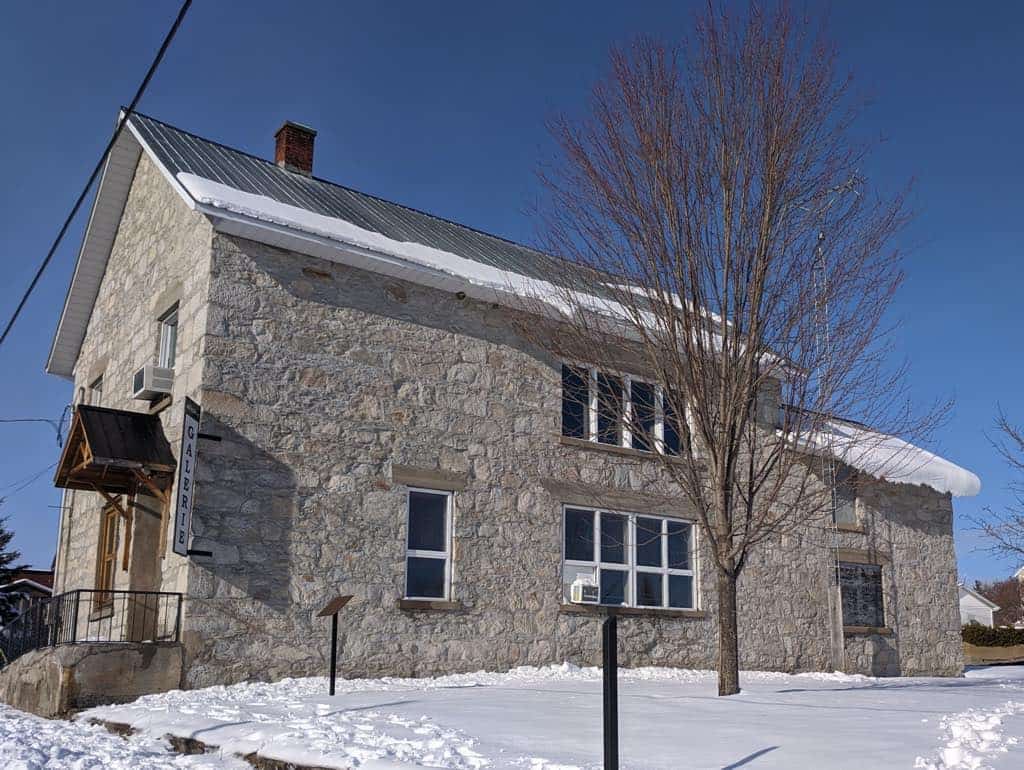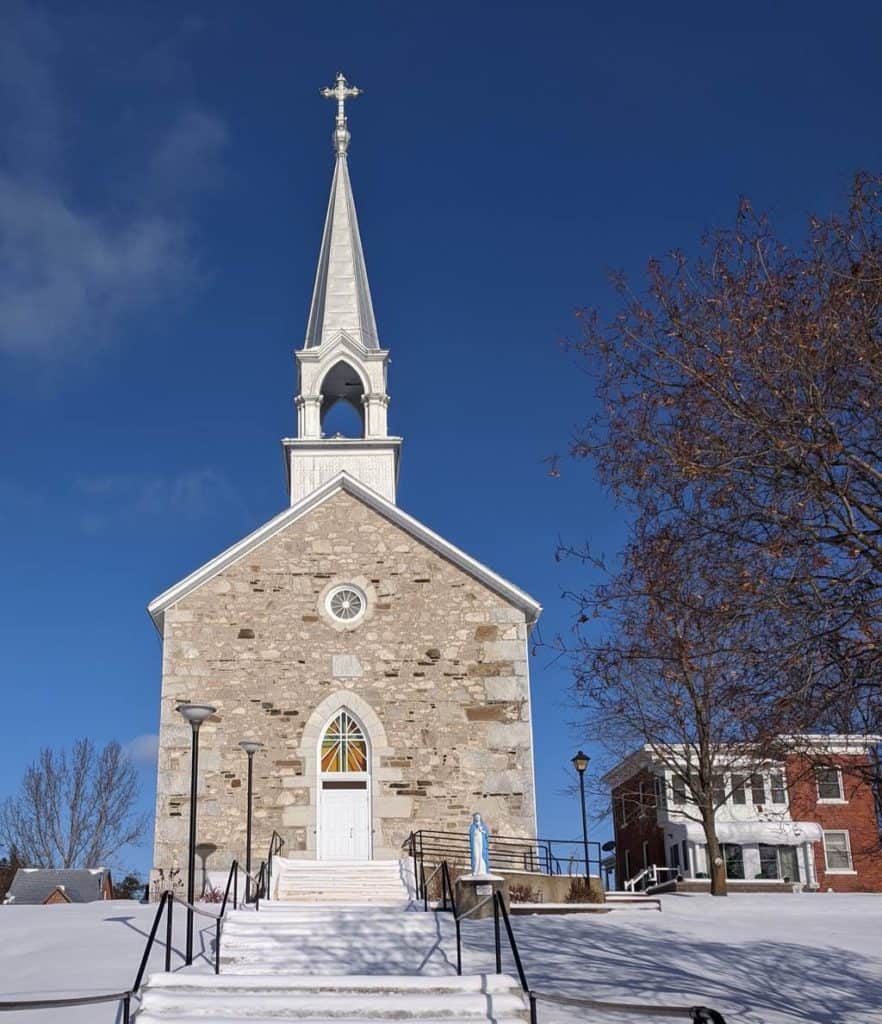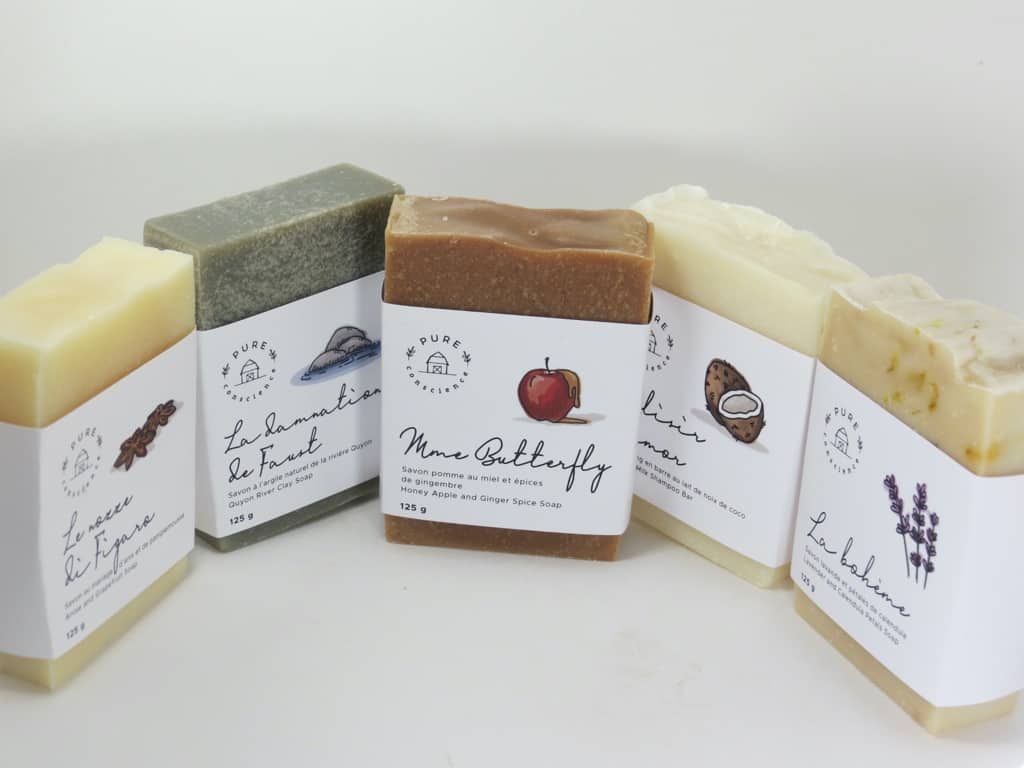Explore Portage-du-Fort, then support local artists and enjoy wonderful wines at the Little Red Wagon Winery’s Christmas Artisans’ Market—all in Quebec’s Pontiac region
Note: As always these days, we urge you to stay close to home on your travels, so this story is aimed particularly at Outaouais readers.
Story by Katharine Fletcher
Did the mention of vino catch your attention, I wonder? What a pairing my story proposes, where I encourage you to visit my home region of the Pontiac, in the Outaouais region of Quebec.
In my estimation, there’s no better way to get the feeling of a village than to walk it—and certainly no better way to discover a wine than to taste it and discuss its merits with the vintners.
And because the Little Red Wagon Winery is hosting its annual Christmas Artisans’ Market this weekend and next (November 28 and 29, and December 4 to 6), it’s a super time to come out to the Pontiac and explore the village of Portage-du-Fort.
Pick up a historical walking tour brochure
So named because a portage helped river travellers bypass serious whitewater rapids along the Ottawa River here, this village has grown up to be a cultural centre. It’s home to two arts organizations: Les Artistes de la Rivière and the Pontiac Artists’ Association.
Along with Les Artistes, the Pontiac Historical Society has created a booklet, Parcours Historique de Portage-du-Fort/Historical Walking Tour of Portage-du-Fort. When you purchase it at Thompson Dépanneur Corner Store (at the corner of rue Main and rue de l’Église in the village), your $10 supports the creation of plaques on the 24 buildings identified in the book. Frances Shea, president of Les Artistes de la Rivière, works tirelessly to create the plaques, which seem to multiply annually.

So pop into the dépanneur (corner store) and buy the booklet. It’s a good place to start your tour, as owners Edward and Nicole Thompson can inform you about the history of the heritage building. Incidentally, Nicole was instrumental in contributing to the tour booklet, so she’s au fait with the village’s stories and the history of other buildings along the route.
Special note: Because winter weather damages the signs, they’ve been removed for the season. However, no worries! You can still do the tour, because the booklet gives you a list of the heritage buildings, along with their addresses, fascinating old photos and explanatory text. If you ask Nicole, perhaps she’ll have time to show you the permanent plaque mounted on her store’s exterior wall (facing rue de l’Église).

A map? The guidebook’s colourful cover, designed by painter Geraldine Classen—a village resident and member of Les Artistes—shows you the village and suggests your route. Parking is free everywhere.
Follow in the footsteps of a governor general’s wife
After visiting the Thompsons, you could drive south one block on rue Main to Harbour Square, identified by the monument beside the Ottawa River, next to the Lakeside Hotel. There’s ample parking there.

The obelisk was erected on the shore of the river, acknowledging Lady Anna Maria Head, wife of then-governor general of the province of Canada, Sir Edmund Walker Head. The monument honours her accomplishment: “To commemorate the visit of Lady Head, who made the tour of the Upper Ottawa in a bark canoe in September, 1856.”

Now, descend to the Ottawa River and look upstream, to your right (west). You’ll spy the Chenaux Generating Station, which provides a vital bridge connecting Ontario and Quebec. The dam forever tamed the rapids here, such that the land you see directly opposite you is an island: Little Limerick.

The necessity of a portage created a place for First Nations—followed by European explorers, priests, settlers and steamboat passengers—to rest, trade goods and spin some yarns. No wonder a trading fort and then a village sprang up, just as they did in Quyon and other communities along this mighty river, our first trans-Canada highway leading to the hinterland.
Time travel to the 19th century
Now, using the booklet as your guide, start exploring. Also along the river, you can see Ratchford Depot and Tanguay House, numbers 12 and 8, rue Craig. At Tanguay House, constructed by stonemason Patrick Ratchford, look at the gable end to appreciate his artistic handiwork: a decorative checkerboard pattern. Considering it was built in 1840, it is one of the many stone buildings here that Lady Head also would have admired after her paddle upriver.
To me, this sort of time travel creates the charm of villages such as “Portage” (as locals call it) in the Ottawa Valley. Using our imaginations, we can still get a sense of what our villages would have looked like back in the day.
Discover buildings with many lives

If the snow’s not deep, walk up Nancy Lane. Otherwise, return to rue Mill and head to number 33, a clapboard house built in 1847. As a member of Artistes de la Rivière, I’ve been fortunate enough to be invited to sell my art inside this lovely home. Not only was it owner Joachim Sauvé’s residence, but it was also this jeweller and watchmaker’s workshop. At one point, it also boasted a lunch counter, as you’ll see in the booklet’s photo. When I was showing my art in the house, with local artists Martina and Larry Evans, people popped in and chatted about once having purchased a bite to eat there.

Many buildings in Portage are intriguing. There’s the Pontiac Artists’ Association’s (PAA’s) Stone School and Gallery, built as Dr. George Purvis’s residence and clinic at 30, rue Mill. It has enjoyed many lives, morphing from a home to a Catholic school, and eventually becoming the PAA’s gallery and school.

Outside, you’ll find a boom boat named the Elisha Beeman, honouring a man who moved here in the early 1800s from New York. A plaque describes the fascinating history of this vessel, which was painted by local artist Nathalie Mantha.

Further down rue Mill, in Parc Brosseau, you’ll find a grindstone supported on a plinth. It recalls John Amy’s grist and woollen mills, which were flooded by the construction of the dam. (Later on, if you walk to chemin Calumet, you can see Amy’s farmhouse.)
See heritage churches and a mansion

Proceeding up the hill by turning right on Highway 301 Nord, you’ll discover St. George’s Anglican Church to your left, then a mansion called Edgewood at 16, rue de l’Église. Ottawans will be interested to learn that this stately home was designed by the same architect, Moses Chamberlain Edey, who designed Ottawa’s famous Aberdeen Pavilion and Horticulture Building in Lansdowne Park.

Rue de l’Église is named for St. James the Greater Roman Catholic Church, which you’ll find after viewing the town hall and public school, all on the north side of the street. Another factoid the booklet mentions is that, in 1856, Bishop Guigues “paid tribute to the raftsmen” by decreeing the balcony of the church would be exclusively reserved for their use.
His decree emphasizes how important the lumbering industry was to the livelihoods of the people of the Pontiac and the Ottawa Valley.
I hope you enjoy discovering this picturesque village, once the shopping centre and major town of the Pontiac region of Quebec. Portage-du-Fort’s situation has pivoted dramatically throughout the centuries: the portage that grew continually morphs.
Learn how fire brought change
On May 18, 1914, a fire swept through Portage. Stonemason Ratchford’s many structures survived, as did a few of the other older buildings you’ve explored on this tour, such as the 1847 clapboard home at 33 rue Mill. After the flames razed the village, it never regained its economic stature in the Pontiac—probably partially due to the start of the First World War that same year. Instead, Shawville became the economic hub of the Pontiac, and Portage-du-Fort is now blossoming as a cultural centre.

We’ve not completed our exploration of the Pontiac. Surely you’ve gained not only knowledge, but thirst and an appetite? If so, drop into the Little Red Wagon Winery, just west of downtown Shawville. Over the next two weekends, it’s holding a Christmas Artisans’ Market.
Sip and shop at the Little Red Wagon Winery

“The Wagon” welcomes you to sample their red, white and (if there’s any left) rosé wines. Try a delectable appetizer platter, featuring many locally produced foods. (Don’t miss the trout pâté.) Buy some bottles for Christmas gifts, perhaps, and purchase local artists’ original creations, too.

You’re in luck if you visit on November 27 or 28, or December 4, 5 or 6, when winery owners Jennifer and Scott Judd will be hosting their annual Christmas Artisans’ Market. This year, a maximum of 25 people are permitted inside at one time, due to COVID-19, but you’ll still be able to browse many artists’ and artisans’ pieces. Purchase unique Christmas gifts—such as fine art, pottery, soaps and lotions, glassworks and much more—from Pontiac-based makers.

Carol Killoran’s beautiful fused-glass ornaments and jewellery will be on sale, as will 100% pure beeswax candles made by Sweet Swarm, another local artisan; soaps and lotions made by Gem Villavicencio; and items created by knitter Rhon Morrison.

Because of the pandemic, the artists won’t be present, but you can still support them by dropping in and seeing their creations. Pick up their business cards and perhaps a gift or two, as well, knowing you’ll be supporting people who create, right here in the Pontiac.
Details: Little Red Wagon Winery, 165, chemin de Calumet ouest, Shawville, Quebec, 819-744-0842. Tasting room currently open from Friday through Sunday, 1pm to 5pm. The Christmas Artisan Market is taking place from 1pm to 5pm on November 28 and 29, and from December 4 to 6.
Katharine Fletcher lives in the Pontiac at her hobby farm, Spiritwood. She is a writer, author of several guidebooks and a visual artist, whose works are represented by Jennifer and Scott Judd’s Little Red Wagon Winery. She invites you to like her Facebook page.
Looking for more tips on things to see and do in the Outaouais, Ottawa and Eastern Ontario? Subscribe to the free weekly Ottawa Road Trips newsletter.

4 comments
Another super browse through surrounding areas – love your posts. Thank you.
Thanks so much, Linda–that’s great to hear! And you’re welcome!
Interested in the history of the old church near the bridge
The walking tour booklet mentioned in the story should have lots of the details that you’re looking for. There are some details about St. George’s here: https://www.archeion.ca/st-georges-church-anglican-portage-du-fort-quebec-fonds